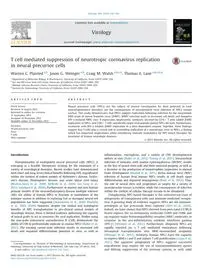
2014 T cell mediated suppression of neurotropic coronavirus replication in neural precursor cells PDF
Preview 2014 T cell mediated suppression of neurotropic coronavirus replication in neural precursor cells
T cell mediated suppression of neurotropic coronavirus replication in neural precursor cells Warren C. Plaisted a,b, Jason G. Weinger a,b, Craig M. Walsh a,b,c,d, Thomas E. Lane a,b,c,d,n a Department of Molecular Biology & Biochemistry, University of California, Irvine 92697-3900, USA b Sue and Bill Gross Stem Cell Center, University of California, Irvine 92697-3900, USA c Multiple Sclerosis Research Center, University of California, Irvine 92697-3900, USA d Institute for Immunology, University of California, Irvine 92697-3900, USA a r t i c l e i n f o Article history: Received 19 August 2013 Returned to author for revisions 17 September 2013 Accepted 14 November 2013 Available online 12 December 2013 Keywords: Neural precursor cells Virus T cells Host response a b s t r a c t Neural precursor cells (NPCs) are the subject of intense investigation for their potential to treat neurodegenerative disorders, yet the consequences of neuroinvasive virus infection of NPCs remain unclear. This study demonstrates that NPCs support replication following infection by the neurotropic JHM strain of mouse hepatitis virus (JHMV). JHMV infection leads to increased cell death and dampens IFN-γ-induced MHC class II expression. Importantly, cytokines secreted by CD4þ T cells inhibit JHMV replication in NPCs, and CD8þ T cells specifically target viral peptide-pulsed NPCs for lysis. Furthermore, treatment with IFN-γ inhibits JHMV replication in a dose-dependent manner. Together, these findings suggest that T cells play a critical role in controlling replication of a neurotropic virus in NPCs, a finding which has important implications when considering immune modulation for NPC-based therapies for treatment of human neurologic diseases. & 2013 Elsevier Inc. All rights reserved. Introduction Transplantation of multipotent neural precursor cells (NPCs) is emerging as a feasible therapeutic strategy for the treatment of a variety of neurological disorders. Recent studies have demonstrated both short and long-term clinical benefits following NPC engraftment within the context of rodent models of Alzheimer's disease, Parkin- son's disease, Huntington's disease, and acute spinal cord injury (Blurton-Jones et al., 2009; McBride et al., 2004; van Gorp et al., 2013; Yasuhara et al., 2006). Furthermore, in murine and non-human primate models of the neuroinflammatory disease multiple sclerosis (MS) the ability of human NPCs to function as modulators of the immune system in addition to replacing lost or damaged neural cell populations has been suggested (Aharonowiz et al., 2008; Pluchino et al., 2003, 2009). However, despite the clinical and histological benefits of NPC transplantation in pre-clinical animal models of neurologic disease, there is limited evidence addressing the capacity of neural grafts to act as reservoirs for viral replication. Studies using the non-polio enterovirus coxsackievirus B (CVB) demonstrate the ability of CVB to preferentially replicate in murine NPCs (Ruller et al., 2012). The ensuing carrier-state infection results in increased cell death and impaired differentiation potential in vitro, as well as inflammation, microgliosis, and a variety of CNS developmental defects in vivo (Ruller et al., 2012; Tsueng et al., 2011). Intracerebral infection of neonates with murine cytomegalovirus (MCMV) results in the loss of neural stem cells and their neuronal progeny, as well as a decrease in the production of neurotrophins imperative to normal brain development (Mutnal et al., 2011). Borna disease virus (BDV) infection of human fetal human NPCs results in cell death upon differentiation and impaired neurogenesis (Brnic et al., 2012). Thus, the role of neural stem and progenitors as targets for a variety of neuroinvasive viruses is evident, while the consequences of infection within the context of cellular therapy remain to be elucidated. Complicating NPC-based therapies is the controversial issue of antigenicity of transplanted cells and immune-mediated recogni- tion. A growing body of evidence suggests NPCs are not immuno- privileged, as has previously been reported (Hori et al., 2003). Indeed, we have shown that NPCs derived from post-natal C57BL/6 brains express the co-stimulatory molecules CD80 and CD86 and up-regulate major histocompatibility complex (MHC) molecules in response to the pro-inflammatory cytokine interferon gamma (IFN-γ) (Weinger et al., 2012). Furthermore, allogeneic NPCs are rapidly rejected via a T cell mediated mechanism following intraspinal transplantation into MHC-mismatched recipients (Weinger et al., 2012). Similarly, human NPCs have the capacity to express MHCs I and II and induce T cell proliferation (Goya et al., 2011). The apparent antigenicity of NPCs suggests successful engraftment may require the use of immunomodulatory agents and lifelong suppression of the immune system, as with solid Contents lists available at ScienceDirect journal homepage: www.elsevier.com/locate/yviro Virology 0042-6822/$ - see front matter & 2013 Elsevier Inc. All rights reserved. http://dx.doi.org/10.1016/j.virol.2013.11.025 n Correspondence to: Division of Microbiology & Immunology, Department of Pathology, University of Utah School of Medicine, Salt Lake City, UT 84112, USA. E-mail address:
